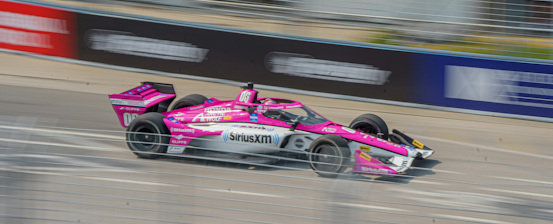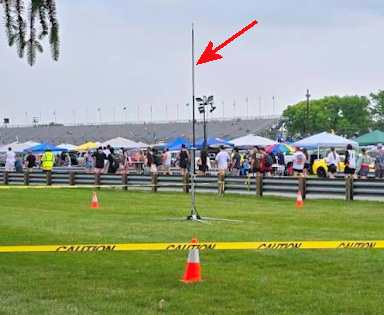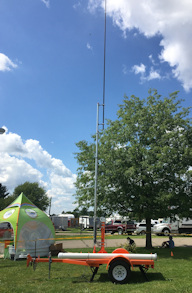 | | Photo by Mateusz Walendzik | | Indy 500: Airing on the Side of Safety | | Health Departments & Emergency Managers Broadcasting Safety & Event Info to Patrons Arriving at Special Events | INDIANAPOLIS, IN: Indiana is the “Crossroads of America” and the historic Indy 500 race happens each year within that very intersection. On Memorial Day weekend 2024, the “Greatest Spectacle in Racing” added an event radio station for fans to monitor as they approached the venue, to deliver instructions about fan safety, parking and traffic.
Marion County Public Health Department’s MRC Logistics Chief Andy Swanson tells The Source, “We broadcasted traffic information and advised about which entrances and exits were open and which intersections were closed. It was very simple our first year; but I foresee it being more involved in 2025.”
Swanson spearheaded the temporary installation on secure property adjacent to the race course. The County’s RadioSTAT Portable Radio Station, which saw extensive duty at points of dispensing (PODS) during the recent Covid Pandemic, was called into service for the Indy 500 race event that often draws more than 300,000 attendees. |  | | Temporary Transmitting Antenna Surrounded by Cones & Caution Tape at 2024 Indianapolis 500 | | Photo by Andy Swanson | | The radio system was procured in 2012 in anticipation of health crises, after bird flu concerns had arisen a few years earlier. Marion County Public Health recently relicensed the system so they could deploy it wherever safety is a concern in the large county, which has boundaries that coincide with those of the City of Indianapolis. Nearby health departments in Boone, Hendricks, Shelby and Morgan Counties operate similar systems, the latter trio having added permanent antennas to enlarge coverage. Morgan County integrated their radio system into their 911 dispatch center and was granted an FCC waiver for expanded coverage. The upgrades proved helpful to the preparedness effort during the April total eclipse. |  | | Hamvention Information Radio Antenna on Trailer Platform at Xenia Fairgrounds Expo Center | | Photo by Bill Baker | Similar EventCAST rental radio systems are licensed each year by Oakland County Michigan emergency managers to provide safety and event information to drivers approaching three large amphitheaters in suburban Detroit: Pine Knob, Meadowbrook and the Michigan Lottery Amphitheater at Freedom Hill. At the Dayton, Ohio, Hamvention each May, a radio system with enhanced range has broadcast event information to attendees since 2018. The three-day convention frequently attracts more than 30,000 HAM radio operators to Southern Ohio. Due to the enlarged signal required, a portable trailer capable of raising the broadcast antenna 30 feet in the air is employed. [See the photo above.] The “Hamvention Information Station” completed its sixth year of operation in 2024, providing amateur radio enthusiasts a creative program that mixes parking, traffic, weather and safety advisories with interviews of local officials.
Operators of events such as concerts, fairs, air shows and sports tournaments – where patrons are exposed to the weather or other safety concerns – may find these radio systems critical to safety should attendees be forced to shelter in their vehicles or exit the venue unexpectedly in an orderly way. |
|  | | Photo by F8 Studio | | AM Radio Isn't Going Away Anytime Soon | WASHINGTON, DC: Perhaps you have heard it expressed, “They don’t even put AM receivers in cars anymore.”
Nothing could be farther from the truth. A bill moving through Congress will soon make that well known. Fact is, more than 99% of the 286 million vehicles on US roads have AM receivers, including 90% of all 2024 vehicles, according to US Senator Debbie Dingell.
So, why might people think their car lacks an AM receiver?
Perhaps it’s because the "AM" selection button is not as apparent on the digital dashboard as it was in the days of analog?
Perhaps it is because a few car makers actually did remove AM, and a few like Ford tried to, before reading the writing on the wall.
But efforts to sideline AM were jammed into reverse in 2023. A consortium of American citizens, Congressmen, the National Association of Broadcasters, former FEMA chiefs and even an FCC Commissioner stood up and called for the attrition stop. America has simply invested too much in the AM radio safety net to let it be pushed aside so car makers could reduce costs.
The movement led to the creation of the bipartisan “AM In Every Vehicle Act” [HR 3413], which has an impressive 254 cosponsors in the House where the bill has recently been approved by the Energy and Commerce Subcommittee. In the Senate, the bill’s support number is 61, a winning number in that body.
If enacted, all carmakers would be required to retain AM receivers in vehicles sold in the United States. “This critical legislation ensures that the 82 million Americans who rely on AM radio each month will continue to have access to diverse programming, local news and essential emergency information,” stated the President of the National Association of Broadcasters (NAB) Curtis LeGeyt, who asserted that “AM Radio is the backbone of our Emergency Alert System.” He pointed out that AM-band signals travel large distances – important in rural areas – and their presence ensures that critical communication services remain available, especially when broadband and cellular services are interrupted. See "What will happen when the internet gets eclipsed," The Source, March 2024.
With hurricane season predicted to be robust in 2024, these facts need little reinforcement on the East and Gulf Coasts. New Jersey Rep Frank Pallone recalled before lawmakers in June how “we used AM Radio to help coordinate relief efforts” after Hurricane Sandy’s devastation. Troy Miller, CEO of the National Religious Broadcasters Association underlined recently, “These stations, which reach 90% of the US population, are equipped to continue broadcasting even in devastating emergency conditions.”
AM is not trendy, true. And if the "AM in Every Vehicle Act" continues at its present speed, it’s also not going away anytime soon.
[Read more about this topic: "AM car radios seem quaint. But when the twister comes, you’ll want that dial," an article that appeared in the Kansas Reflector.] |
|

